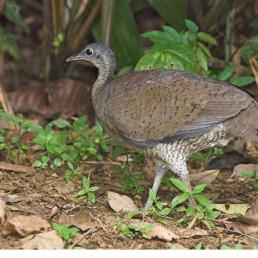

Join BirdNote tomorrow, November 30th!
Illustrator David Sibley and actor H. Jon Benjamin will face off in the bird illustration battle of the century during BirdNote's Year-end Celebration and Auction!
All birds lack the typical gene for detecting sweetness, but hummingbirds avidly seek out sugary nectar. It turns out that evolution has transformed hummers’ taste receptors. Mutations to their savory taste receptor gene allowed the receptor to respond to sucrose and other sugars. Scientists haven’t yet uncovered the evolutionary story for other nectar specialists such as honeyeaters and sunbirds.
BirdNote®
How Hummingbirds Got Their Sweet Tooth
Written by Bob Sundstrom
This is BirdNote.
[Rivoli’s Hummingbird call and wing sounds, https://macaulaylibrary.org/asset/121948#_ga=2.238886848.131896634.1564…, 0.05-.09]
If any bird has a sweet tooth, it’s got to be a hummingbird — right? They’re the prime nectar specialists of the Western Hemisphere. But all birds lack the typical gene for detecting sweetness. So how do hummingbirds so avidly seek and drink sugar?
[Rivoli’s Hummingbird call and wing sounds, https://macaulaylibrary.org/asset/121948#_ga=2.238886848.131896634.1564…, 0.07-.09]
Mammals typically have three kinds of taste receptor genes: one for savory, one for sweet, and another for salty. Less is known of birds’ taste receptor genes. But many, including hummers, appear to have one for savory.
When researchers compared the hummers’ savory receptor gene with those of other birds, they found a novel evolutionary twist. Changes through mutation had allowed their savory receptors to respond to sucrose and other sugars. So in essence, the savory receptor genes effectively functioned as sweet receptor genes. We don’t know what the taste sensation is, but hummers can’t seem to get enough of that sweet, sugary nectar.
[Broad-tailed Hummingbird wing sounds, https://macaulaylibrary.org/asset/6177#_ga=2.51265129.131896634.1564519…, 0.12-.16]
In the Eastern Hemisphere, honeyeaters and sunbirds, two unrelated groups, are the nectar specialists. But the story of their taste receptor genes has yet to be uncovered.
For BirdNote, I’m Michael Stein.
###
Producer: John Kessler
Executive Producer: Sallie Bodie
Producer: Mark Bramhill
Associate Producer: Ellen Blackstone
Digital Producer: Conor Gearin
Bird sounds provided by The Macaulay Library of Natural Sounds at the Cornell Lab of Ornithology, Ithaca, New York. Rivoli Hummingbird ML121948 recorded by C. Marantz, Broad-tailed Hummingbird ML6177 recorded by R. Stein and R. Angstadt.
BirdNote’s theme was composed and played by Nancy Rumbel and John Kessler.
© 2021 BirdNote June 2021 Narrator: Michael Stein
ID# taste-02-2021-06-03 taste-02
References:
John Reilly, The Ascent of Birds. Pelagic Publishing, 2018.
https://baynature.org/article/ask-naturalist-can-hummingbirds-taste-foo…
https://www.insidescience.org/video/why-hummingbirds-have-sweet-tooth
https://www.ncbi.nlm.nih.gov/pmc/articles/PMC4764331/



